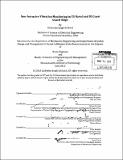Non-intrusive vibration monitoring in US Naval and US Coast Guard ships
Author(s)
Gerhard, Katherine Leigh
DownloadFull printable version (31.83Mb)
Alternative title
Non-intrusive vibration monitoring in United States Naval and United States Coast Guard ships
Other Contributors
Massachusetts Institute of Technology. Department of Mechanical Engineering.
Advisor
Steven B. Leeb, Patrick Hale and Chris Schantz.
Terms of use
Metadata
Show full item recordAbstract
In 2011, the Laboratory for Electromagnetic and Electronic Systems proposed a new type of vibration monitoring system, entitled vibration assessment monitoring point with integrated recovery of energy or VAMPRIE, in their work entitled VAMPIRE: Accessing a Life-Blood of Information for Maintenance and Damage Assessment [1]. The proposed monitoring system includes a self-power harvesting accelerometer installed in motors on US Navy and US Coast Guard vessels used to monitor equipment vibration and diagnose the source of the high vibrations. Utilizing the observations and tools designed by the VAMPIRE project as a foundation, this thesis takes the LEES lab-designed CAPTCHA accelerometers to the US Navy and US Coast Guard fleets to test the lab-designed tool, collect ship equipment data, and verify the VAMPIRE concepts. The CAPTCHA's ability to monitor the vibrations of these systems could be used to immediately diagnose system casualties, aid in parts repair, and ultimately, become a tool to promote Condition-Based Maintenance (CBM). Measurements and experimentation were conducted on two USCG ventilation fans in the lab as well as onboard the USCGC SENECA (WMEC-906), USCGC BERTHOLF (WMSL 750), USCGC STRATTON (WMSL 752), USS MICHAEL MURPHY (DDG 112), USS INDEPENDENCE (LCS 2), and USS SAN DIEGO (LPD 22). Data was collected and analyzed using a MATLAB program developed to diagnose the types of vibrations seen in various experiments and observe high vibrations in the commissioned ships. The combined results of the CAPTCHA-recorded lab tests and ship testing corroborate the theories proposed in the VAMPIRE paper; however, additional studies could make the VAMPIRE proposal a robust solution to a fleet-wide vibration-induced maintenance problem.
Description
Thesis (Nav. E. and S.M.)--Massachusetts Institute of Technology, Dept. of Mechanical Engineering, 2013. Cataloged from PDF version of thesis. Includes bibliographical references (p. 134-135).
Date issued
2013Department
Massachusetts Institute of Technology. Department of Mechanical EngineeringPublisher
Massachusetts Institute of Technology
Keywords
Mechanical Engineering.